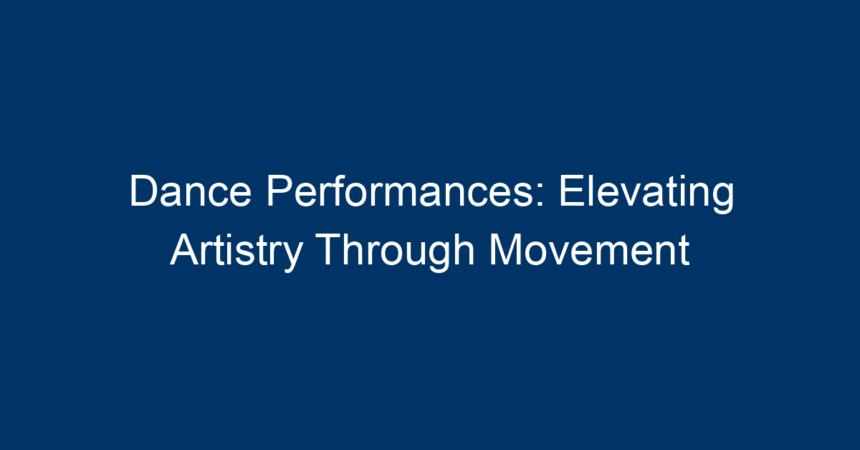Dance performances are a captivating form of expression that transcend language, culture, and age. As a powerful medium of communication, dance tells stories and conveys emotions through intricate movements, rhythms, and choreography. Whether it’s a fiery ballet displaying elegance or a contemporary piece that challenges societal norms, dance performances effortlessly elevate artistry through sheer movement. In this article, we will explore the significance of dance performances, their historical context, various styles, and how they connect audiences with profound emotions.
The Significance of Dance Performances
The Power of Expression
At its core, a dance performance is a powerful form of artistic expression. Dancers convey emotions, narratives, and themes that resonate deeply with audiences. From joy to sorrow, love to loss, dance encapsulates the human experience in ways words often cannot. This profound capability allows dance performances to bridge cultural gaps, making it a universal language.
Cultural Heritage and Identity
Dance performances are also pivotal in preserving cultural heritage. Traditional dances reflect the history, beliefs, and values of specific communities and encourage the transmission of cultural identity to future generations. Many cultures celebrate festivals or significant events with dance, making it an intrinsic part of social life.
Community and Connection
Dance performances often create a sense of community among performers and audiences. Whether in a small theater or a grand auditorium, spectators share the experience, leading to a collective emotional journey. This connection fosters empathy and understanding, further enhancing the impact of the performance.
A Brief History of Dance in Performance Art
Ancient Roots
Dance has existed for millennia, with ancient civilizations like the Egyptians, Greeks, and Chinese incorporating dance into their rituals and celebrations. These early forms of dance often had spiritual significance, serving as a means to connect with the divine.
The Renaissance and Baroque Periods
The Renaissance marked a significant evolution in dance, emphasizing grace and artistry. This period saw the rise of ballet, with structured choreography and formal training, paving the way for modern dance performances. The Baroque period refined these elements, leading to elaborate court dances that showcased the skills of both the dancer and the choreographer.
Emergence of Modern Dance
In the early 20th century, modern dance emerged as a counter-movement to classical ballet. Innovators like Martha Graham and Merce Cunningham broke traditional boundaries, emphasizing individual expression and improvisation. This new form allowed for a wider variety of styles and interpretations in dance performances.
Types of Dance Performances
Classical Ballet
Classical ballet is known for its elegance, precision, and storytelling. With a rich history dating back to the 15th century, performances typically include a formal structure, including acts and scenes, as seen in iconic ballets like “Swan Lake” and “The Nutcracker.” The intricate choreography and stunning costumes make ballet a timeless art form.
Contemporary Dance
Contemporary dance draws from a multitude of genres, including ballet, jazz, and even hip-hop. It often challenges traditional norms, incorporating elements like improvisation and varied movement styles. Performances can be abstract, allowing audiences to interpret meanings personally. Contemporary dance reflects current societal themes, making it highly relevant.
Jazz and Musical Theatre
Jazz dance combines elements of African American vernacular dance with influences from Broadway and the theater. Often energetic and expressive, jazz performances captivate audiences with their rhythm and flair. Musical theatre integrates dance with storytelling through song and dialogue, creating an immersive emotional experience.
Folk and Traditional Dance
Folk and traditional dances are deeply rooted in cultural heritage. Each genre tells a story, often celebrating community values and traditions. Performances like Irish step dancing and Indian classical dance encapsulate the essence of their respective cultures, fostering appreciation and understanding.
The Role of Choreography in Dance Performances
Crafting Movement
Choreography is the backbone of any dance performance. It involves creating structured movement sequences that reflect the performance’s theme and emotional tone. A skilled choreographer blends various styles, techniques, and storytelling elements, allowing dancers to interpret and embody the message effectively.
Collaborative Creativity
Choreography often involves collaboration between dancers and choreographers. Through this creative partnership, both the movement and its emotional resonance evolve. Dancers bring their unique perspectives and interpretations, enriching the final performance through diverse artistic voices.
Enhancing Audience Experience
The choreography’s intent is not only to showcase technical skills but to immerse the audience in an emotional journey. Thoughtful choreography can elicit responses ranging from awe to introspection, creating an engaging experience that lingers long after the performance concludes.
The Impact of Dance Performances on Audiences
Emotional Connection
One of the most profound impacts of dance performances is their ability to create emotional connections. Through movement, dancers convey sentiments that resonate with individual experiences, triggering memories and feelings within the audience. Such connections foster empathy and understanding across different perspectives.
Inspiration and Reflection
Dance performances often inspire audiences to reflect on their lives and societal issues. They serve as a mirror, prompting viewers to explore their beliefs and values. This reflective nature can ignite social change, prompting discussions around relevant topics showcased in the performance.
Expanding Cultural Awareness
Attending dance performances can broaden horizons and deepen cultural awareness. Exposure to various styles and traditions fosters appreciation for diversity, encouraging audiences to explore the richness of different cultures through dance.
How to Engage with Dance Performances
Attend Live Shows
Experience the magic of dance performances by attending live shows. Local theaters, cultural centers, and festivals often feature various dance styles, allowing you to immerse yourself in the artistry firsthand.
Support Dance Companies and Artists
Supporting local dance companies or independent artists helps sustain the art form. Attend fundraisers, donate, or participate in workshops to contribute to the growth of the dance community in your area.
Explore Online Platforms
With the rise of digital media, countless dance performances are now available online. Explore platforms like YouTube or Vimeo for recorded performances, allowing you to witness various styles from the comfort of your home.
Participate in Dance Classes
Why not try your hand at dancing? Participating in dance classes enriches your understanding of the art form while providing a creative outlet. Whether it’s ballet, hip-hop, or salsa, dance classes are an exciting way to connect with this expressive medium.
Conclusion: Dance as an Ever-Evolving Art Form
Dance performances encapsulate a world of artistry through movement, offering unique perspectives on life, culture, and emotion. These performances serve as a conduit for expression, allowing both dancers and audiences to explore the human experience. By embracing the various styles of dance and supporting the dance community, we contribute to an evolving art form that continues to inspire and connect people worldwide.
As you engage with dance performances, remember that this art form is more than just a display of skill; it’s a celebration of our shared humanity. So, step into the world of dance, and let the artistry elevate your perspective through the poetry of movement.




